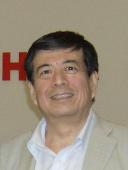Keynote Addresses
Opening & Keynote I : Tuesday, January 20, 8:30-10:00, Small Auditorium, 5F
Challenges to EDA System from the View Point of Processor Design and Technology Drivers

Mitsuo Saito
Chief Fellow and VP of Engineering
Toshiba Corporation Semiconductor Company, Japan
Historically, many microprocessors have been developed, since it was invented in early 1970's. Microprocessor design was always under the hardest competition, so they had been the technology driver for the semiconductor technology and the design methodology until recently.
By discussing the relationship between the design methodology (EDA) revolution and the technology driver products transition, based upon famous Makimoto's wave hypothesis, what happened to the microprocessor world is highlighted by showing typical examples.
As a recent example, the positioning of the Cell Broadband Engine as a high performance computing processor and as a flexible HW, is discussed mainly, also the performance result, and the future trend of the microprocessors towards multi-core are discussed. Then it is explained, why SpursEngine derived from Cell Broadband Engine had to be developed.
SoC (combination of microprocessor and HW functional unit) for custom applications should be the technology driver, for the next decade, which is the first experience after microprocessor was born. The special requirements to the EDA system to realize next wave, are predicted.
Finally, when the next wave comes, maybe after 2017, software centric era, what happens to the world, is briefly mentioned.
Keynote II : Wednesday, January 21, 9:00-10:00, Small Auditorium, 5F
Automated Synthesis and Verification of Embedded Systems: Wishful Thinking or Reality?

Wolfgang Rosenstiel
Professor, Chair for Computer Engineering and Director
Wilhelm-Schickard-Institute for Informatics, University of Tuebingen, Germany
More complex embedded hardware/software systems have to be developed with shorter design time and reduced cost. One solution for this problem is increasing design automation starting from higher levels of abstraction. Automatic synthesis and verification has been around in research for a quite a while. This talk will show examples for state-of-the art tools for system-level synthesis and verification of embedded systems and demonstrate their possibilities and limitations by some automotive applications.
Keynote III : Thursday, January 22, 9:00-10:00, Small Auditorium, 5F
From Restrictive to Prescriptive Design

Leon Stok
Director, Electronic Design Automation
IBM Systems and Technology Group, United States
For many generations the hand-off between design and manufacturing has been done by a set of design rules. However, design rule manuals have grown in size from several tens of pages a few generations back to hundreds of pages now. Many more design rules have been added since the end of traditional scaling. Even with all these additional rules, corner cases are found late in the process that can become significant yield or functionality detractors. Restricted Design Rules (RDRs) have been created to simplify the design rules and come up with more manufacturable designs. IBM has practiced RDRs in the last few process generations but is this enough? For the next technology nodes no new exposure tools will be available for mass production and optical scaling is coming to a halt. Computational scaling will be required to extend Moore's law. In this new era, can we keep on describing design rules in terms of restrictions or do we need another approach?








